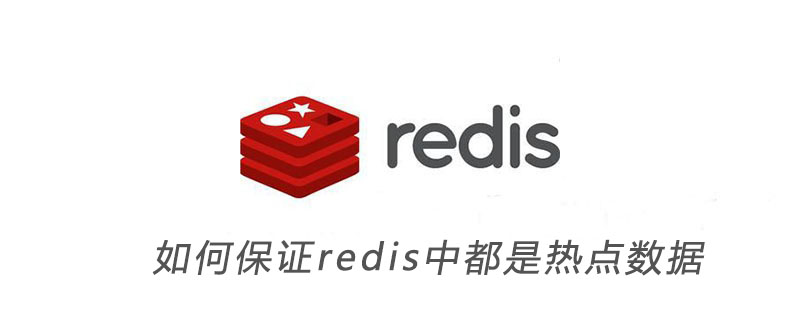如何保證redis中都是熱點數據

當redis使用的記憶體超過了設定的最大記憶體時,會觸發redis的key淘汰機制,在redis 3.0中有6種淘汰策略:
noeviction: 不刪除策略。當達到最大記憶體限制時, 如果需要使用更多記憶體,則直接傳回錯誤訊息。 (redis預設淘汰策略)
allkeys-lru: 在所有key中優先刪除最近最少使用(less recently used ,LRU) 的 key。 (建議學習:Redis影片教學)
allkeys-random: 在所有key中隨機刪除一部分 key。
volatile-lru: 在設定了超時時間(expire )的key中優先刪除最近最少使用(less recently used ,LRU) 的 key。
volatile-random: 在設定了逾時時間(expire)的key中隨機刪除一部分 key。
volatile-ttl: 在設定了超時時間(expire )的key中優先刪除剩餘時間(time to live,TTL) 短的key。
場景:
資料庫中有1000w的數據,而redis只有50w數據,如何保證redis中10w數據都是熱點數據?
方案:
限定 Redis 佔用的內存,Redis 會根據自身資料淘汰策略,留下熱資料到記憶體。 所以,計算一下 50W 資料大約佔用的內存,然後設定 Redis 內存限制即可,並將淘汰策略為volatile-lru或allkeys-lru。
設定Redis最大佔用記憶體:
#開啟redis設定文件,設定maxmemory參數,maxmemory是bytes位元組類型
# In short... if you have slaves attached it is suggested that you set a lower # limit for maxmemory so that there is some free RAM on the system for slave # output buffers (but this is not needed if the policy is 'noeviction'). # # maxmemory <bytes> maxmemory 268435456
#設定過期策略:
maxmemory-policy volatile-lru
更多Redis相關技術文章,請造訪Redis入門教學欄位學習!
以上是如何保證redis中都是熱點數據的詳細內容。更多資訊請關注PHP中文網其他相關文章!

熱AI工具

Undresser.AI Undress
人工智慧驅動的應用程序,用於創建逼真的裸體照片

AI Clothes Remover
用於從照片中去除衣服的線上人工智慧工具。

Undress AI Tool
免費脫衣圖片

Clothoff.io
AI脫衣器

AI Hentai Generator
免費產生 AI 無盡。

熱門文章

熱工具

記事本++7.3.1
好用且免費的程式碼編輯器

SublimeText3漢化版
中文版,非常好用

禪工作室 13.0.1
強大的PHP整合開發環境

Dreamweaver CS6
視覺化網頁開發工具

SublimeText3 Mac版
神級程式碼編輯軟體(SublimeText3)

熱門話題
 redis集群模式怎麼搭建
Apr 10, 2025 pm 10:15 PM
redis集群模式怎麼搭建
Apr 10, 2025 pm 10:15 PM
Redis集群模式通過分片將Redis實例部署到多個服務器,提高可擴展性和可用性。搭建步驟如下:創建奇數個Redis實例,端口不同;創建3個sentinel實例,監控Redis實例並進行故障轉移;配置sentinel配置文件,添加監控Redis實例信息和故障轉移設置;配置Redis實例配置文件,啟用集群模式並指定集群信息文件路徑;創建nodes.conf文件,包含各Redis實例的信息;啟動集群,執行create命令創建集群並指定副本數量;登錄集群執行CLUSTER INFO命令驗證集群狀態;使
 redis底層怎麼實現
Apr 10, 2025 pm 07:21 PM
redis底層怎麼實現
Apr 10, 2025 pm 07:21 PM
Redis 使用哈希表存儲數據,支持字符串、列表、哈希表、集合和有序集合等數據結構。 Redis 通過快照 (RDB) 和追加只寫 (AOF) 機制持久化數據。 Redis 使用主從復制來提高數據可用性。 Redis 使用單線程事件循環處理連接和命令,保證數據原子性和一致性。 Redis 為鍵設置過期時間,並使用 lazy 刪除機制刪除過期鍵。
 redis-server找不到怎麼辦
Apr 10, 2025 pm 06:54 PM
redis-server找不到怎麼辦
Apr 10, 2025 pm 06:54 PM
解決redis-server找不到問題的步驟:檢查安裝,確保已正確安裝Redis;設置環境變量REDIS_HOST和REDIS_PORT;啟動Redis服務器redis-server;檢查服務器是否運行redis-cli ping。
 redis怎麼讀源碼
Apr 10, 2025 pm 08:27 PM
redis怎麼讀源碼
Apr 10, 2025 pm 08:27 PM
理解 Redis 源碼的最佳方法是逐步進行:熟悉 Redis 基礎知識。選擇一個特定的模塊或功能作為起點。從模塊或功能的入口點開始,逐行查看代碼。通過函數調用鏈查看代碼。熟悉 Redis 使用的底層數據結構。識別 Redis 使用的算法。
 redis怎麼讀取隊列
Apr 10, 2025 pm 10:12 PM
redis怎麼讀取隊列
Apr 10, 2025 pm 10:12 PM
要從 Redis 讀取隊列,需要獲取隊列名稱、使用 LPOP 命令讀取元素,並處理空隊列。具體步驟如下:獲取隊列名稱:以 "queue:" 前綴命名,如 "queue:my-queue"。使用 LPOP 命令:從隊列頭部彈出元素並返回其值,如 LPOP queue:my-queue。處理空隊列:如果隊列為空,LPOP 返回 nil,可先檢查隊列是否存在再讀取元素。
 redis怎麼查看所有的key
Apr 10, 2025 pm 07:15 PM
redis怎麼查看所有的key
Apr 10, 2025 pm 07:15 PM
要查看 Redis 中的所有鍵,共有三種方法:使用 KEYS 命令返回所有匹配指定模式的鍵;使用 SCAN 命令迭代鍵並返回一組鍵;使用 INFO 命令獲取鍵的總數。
 redis計數器怎麼實現
Apr 10, 2025 pm 10:21 PM
redis計數器怎麼實現
Apr 10, 2025 pm 10:21 PM
Redis計數器是一種使用Redis鍵值對存儲來實現計數操作的機制,包含以下步驟:創建計數器鍵、增加計數、減少計數、重置計數和獲取計數。 Redis計數器的優勢包括速度快、高並發、持久性和簡單易用。它可用於用戶訪問計數、實時指標跟踪、遊戲分數和排名以及訂單處理計數等場景。
 redis指令怎麼用
Apr 10, 2025 pm 08:45 PM
redis指令怎麼用
Apr 10, 2025 pm 08:45 PM
使用 Redis 指令需要以下步驟:打開 Redis 客戶端。輸入指令(動詞 鍵 值)。提供所需參數(因指令而異)。按 Enter 執行指令。 Redis 返迴響應,指示操作結果(通常為 OK 或 -ERR)。






